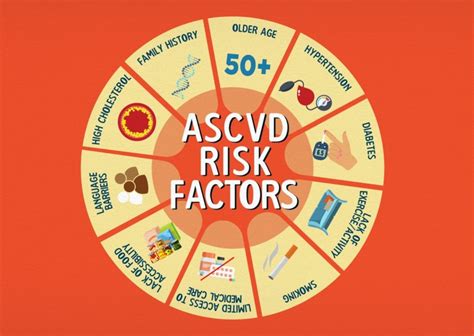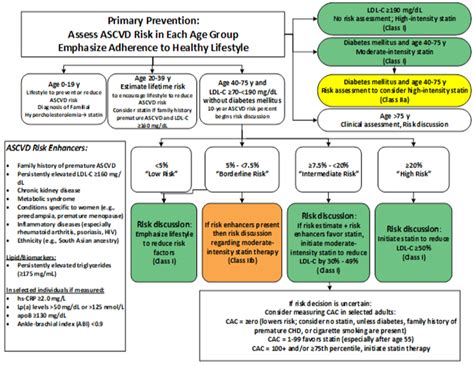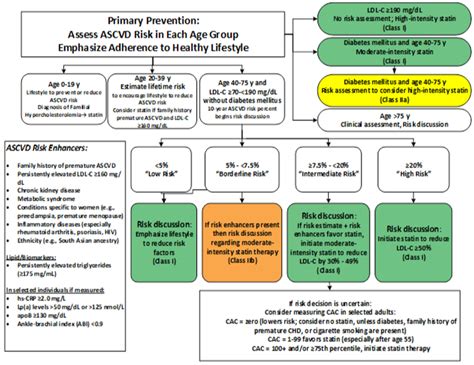Intro
Assess your heart health with our in-depth guide to 10-year ASCVD risk. Learn how to calculate your risk of atherosclerotic cardiovascular disease, understand the impact of risk factors such as high cholesterol, smoking, and diabetes, and discover strategies to reduce your risk and prevent heart disease. Get informed and take control of your cardiovascular health.
The 10-year ASCVD risk assessment has become a crucial tool in the prevention and management of atherosclerotic cardiovascular disease (ASCVD). ASCVD is a condition where plaque builds up in the arteries, leading to reduced or blocked blood flow, which can cause heart attacks, strokes, and other cardiovascular events. By estimating an individual's 10-year risk of developing ASCVD, healthcare providers can identify those who are at high risk and provide targeted interventions to reduce their risk.

The 10-year ASCVD risk assessment is based on several factors, including age, sex, total and HDL (good) cholesterol levels, blood pressure, diabetes status, and smoking status. By considering these factors, the assessment can provide an estimate of an individual's risk of developing ASCVD over the next 10 years. This information can be used to guide treatment decisions, such as the initiation of statin therapy or blood pressure medications, and to encourage lifestyle changes to reduce risk.
Understanding the 10-Year ASCVD Risk Assessment
The 10-year ASCVD risk assessment is calculated using a complex algorithm that takes into account the individual's risk factors. The assessment is typically performed using a calculator or online tool, such as the American College of Cardiology (ACC) ASCVD Risk Estimator. The calculator uses the following inputs:
- Age
- Sex
- Total cholesterol level
- HDL cholesterol level
- Blood pressure
- Diabetes status
- Smoking status

Based on these inputs, the calculator provides an estimate of the individual's 10-year risk of developing ASCVD, expressed as a percentage. For example, a 10-year risk of 10% means that the individual has a 10% chance of developing ASCVD over the next 10 years.
Interpreting the Results
The results of the 10-year ASCVD risk assessment are interpreted as follows:
- Low risk: Less than 5%
- Borderline risk: 5-7.4%
- Intermediate risk: 7.5-19.9%
- High risk: 20% or higher
Individuals with a high 10-year ASCVD risk are considered to be at increased risk of developing cardiovascular disease and may benefit from more aggressive treatment, such as statin therapy or blood pressure medications. Those with a low or borderline risk may still benefit from lifestyle changes, such as a healthy diet and regular exercise, to reduce their risk.
Benefits of the 10-Year ASCVD Risk Assessment
The 10-year ASCVD risk assessment has several benefits, including:
- Improved risk stratification: The assessment provides a more accurate estimate of an individual's risk of developing ASCVD, allowing for targeted interventions.
- Personalized treatment: The assessment can be used to guide treatment decisions, such as the initiation of statin therapy or blood pressure medications.
- Increased awareness: The assessment can increase awareness of ASCVD risk and encourage individuals to make lifestyle changes to reduce their risk.
- Cost-effective: The assessment is a cost-effective way to identify individuals at high risk of developing ASCVD.

Limitations of the 10-Year ASCVD Risk Assessment
While the 10-year ASCVD risk assessment is a valuable tool, it has several limitations, including:
- Limited accuracy: The assessment is based on a complex algorithm and may not accurately estimate risk for all individuals.
- Lack of consideration of other risk factors: The assessment does not consider other risk factors, such as family history or inflammatory markers.
- Need for regular updates: The assessment should be updated regularly to reflect changes in risk factors.
Practical Applications of the 10-Year ASCVD Risk Assessment
The 10-year ASCVD risk assessment has several practical applications, including:
- Primary prevention: The assessment can be used to identify individuals at high risk of developing ASCVD and provide targeted interventions to reduce their risk.
- Secondary prevention: The assessment can be used to monitor individuals with established ASCVD and adjust treatment as needed.
- Research: The assessment can be used in research studies to identify individuals at high risk of developing ASCVD and evaluate the effectiveness of interventions.

Future Directions
The 10-year ASCVD risk assessment is a rapidly evolving field, with ongoing research focused on improving the accuracy and practicality of the assessment. Future directions include:
- Development of new risk scores: Researchers are working to develop new risk scores that incorporate additional risk factors, such as inflammatory markers or genetic information.
- Use of machine learning algorithms: Machine learning algorithms may be used to improve the accuracy of the assessment and identify new risk factors.
- Integration with electronic health records: The assessment may be integrated with electronic health records to facilitate its use in clinical practice.
What is the 10-year ASCVD risk assessment?
+The 10-year ASCVD risk assessment is a tool used to estimate an individual's risk of developing atherosclerotic cardiovascular disease (ASCVD) over the next 10 years.
How is the 10-year ASCVD risk assessment calculated?
+The assessment is calculated using a complex algorithm that takes into account several risk factors, including age, sex, total and HDL cholesterol levels, blood pressure, diabetes status, and smoking status.
What are the benefits of the 10-year ASCVD risk assessment?
+The assessment provides improved risk stratification, personalized treatment, increased awareness, and is cost-effective.
In conclusion, the 10-year ASCVD risk assessment is a valuable tool in the prevention and management of ASCVD. By estimating an individual's risk of developing ASCVD, healthcare providers can identify those at high risk and provide targeted interventions to reduce their risk. While the assessment has several limitations, it remains a practical and effective tool in clinical practice. We encourage readers to share their thoughts and experiences with the 10-year ASCVD risk assessment in the comments below.
